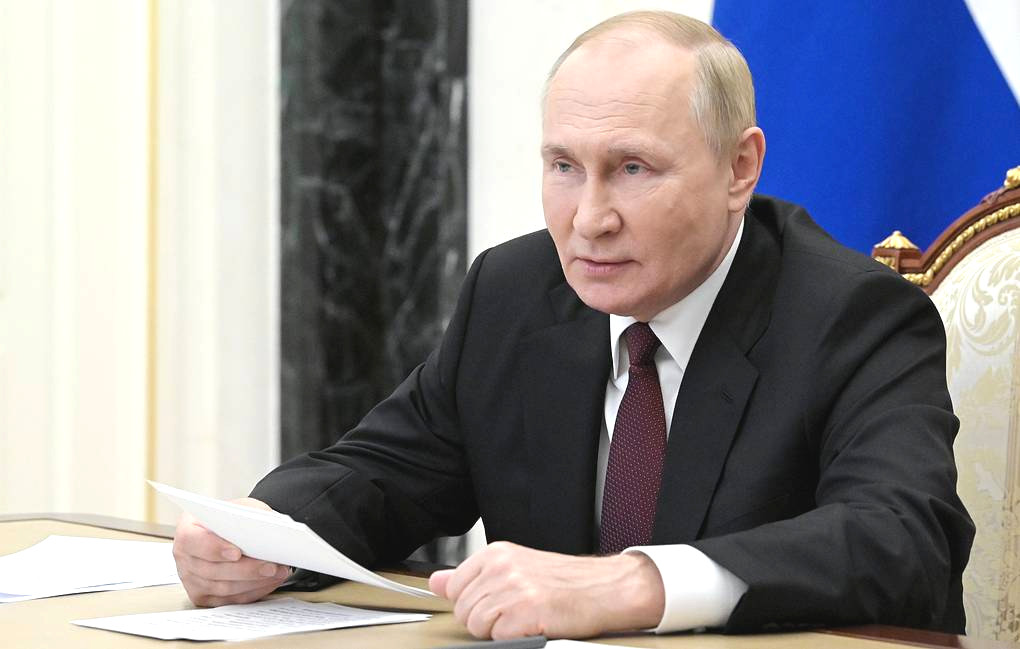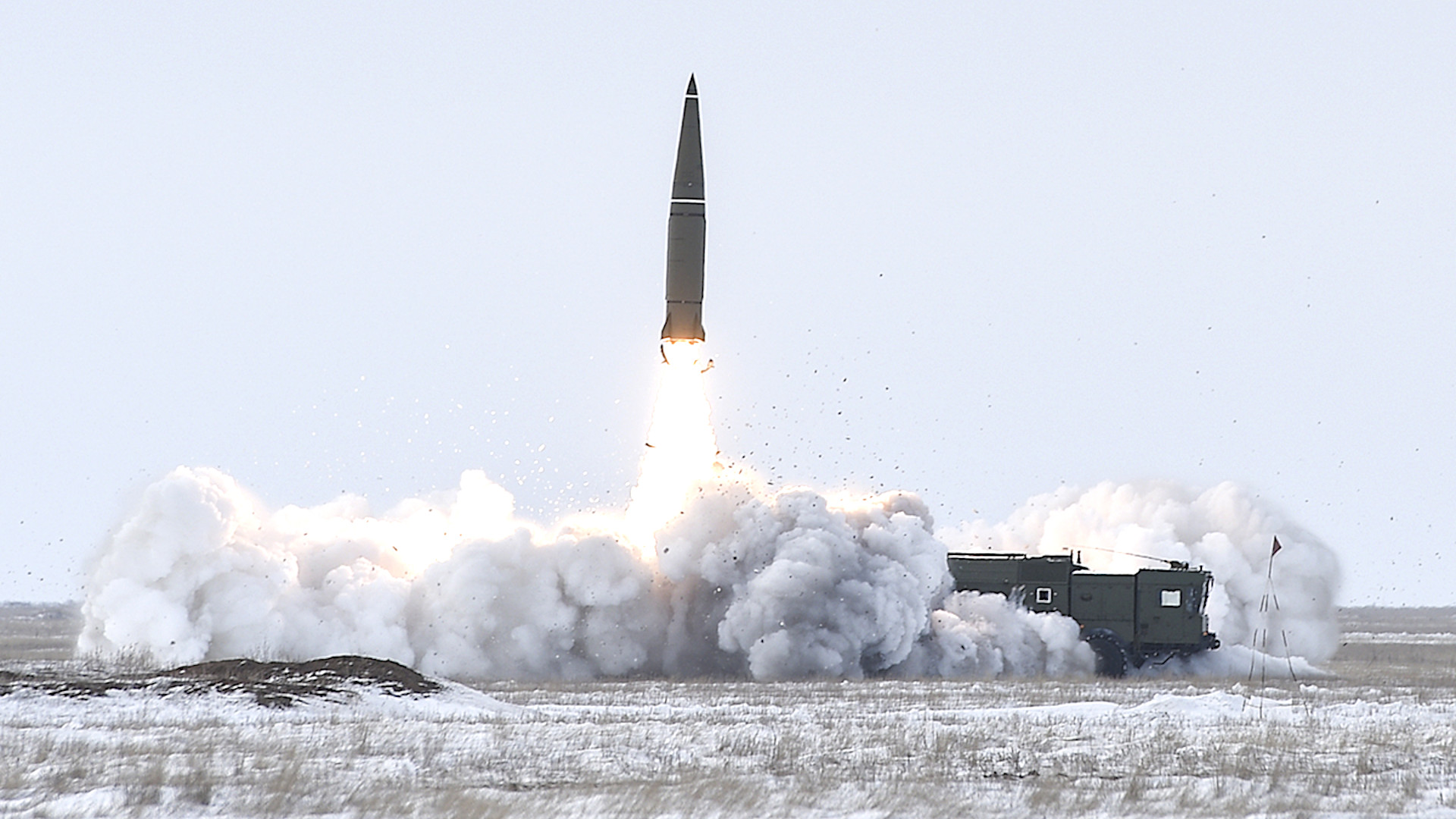State media in Russia today put forward a new twist on so far completely unsubstantiated claims that Ukrainian forces are planning to detonate a so-called “dirty bomb” in the country and blame it on their Russian opponents. The new and extremely over-complicated claim is authorities in Ukraine plan to build a mock Russian Iskander-M short-range ballistic missile, load it with hazardous nuclear material, and then shoot it down or blow it up over the Chernobyl Exclusion Zone.
All week, President Vladimir Putin and other senior Russian officials have continued to push evidenceless dirty bomb allegations, in general, prompting fears that this could be a prelude to some kind of nuclear false flag operation or a pretext for some other serious escalation. You can read more about how this narrative has already been evolving in The War Zone‘s previous reporting on the issue here.
Russian state media outlet Sputnik reported the new purported fake Iskander dirty bomb plot today in a brief story cited to a single unnamed “source familiar with the situation.” Unlike a true nuclear weapon, a dirty bomb is a conventional explosive device intended to spread dangerous radioactive material. Experts have long debated the actual threat such a weapon might pose, but it certainly has the potential to spark panic and chaos due to the nature of its components.

“Experts from the Yuzhmash plant have already made a dummy missile of the Iskander system, the head cluster part of which is planned to be filled with radioactive material, and then ‘shot down’ by Ukrainian air defense forces over the exclusion zone of the Chernobyl nuclear power plant in order to declare a Russian launch of a nuclear charge,” Sputnik claimed the source told the outlet. “After the dummy is shot down, the Kiev [Kyiv] authorities intend to show the Western and Ukrainian media fragments of the mockup and electronics of the alleged Iskander missile in order to convince the Western public of Russia’s guilt.”
The source also allegedly said that an older, smaller, and otherwise unrelated Tochka-U short-range ballistic missile – a Soviet-era type originally made in Russia that both Russian and Ukrainian forces have employed in the current conflict – would be used as the basis for the faux Iskander.
Yuzhmash, now called Pivdenmash, is a Ukrainian aerospace conglomerate that was founded in the Soviet era and has a long history of involvement in the development of ballistic missiles, as well as space launch rockets. However, neither Sputnik nor its ‘source’ provided any evidence to substantiate these claims.
Officials in Moscow and Kyiv have traded accusations about potential nuclear or radiological provocations – including about potential dirty bomb usage – on multiple occasions since Russia launched its all-out invasion in February. The Russian military’s seizure of the now-defunct Chernobyl nuclear power plant, and areas of the surrounding exclusion zone that was put into place after the infamous disaster there in 1986, in the opening phases of the conflict triggered one round of allegations. Ukrainian forces have since liberated those areas. More recently, similar concerns have and continue to surround Russia’s occupation of the Zaporizhzhya Nuclear Power Plant (ZNPP) in southeastern Ukraine.
However, this new round of dirty bomb allegations appears to have picked up steam with claims Russian Defense Minister Sergei Shoigu made during phone calls with various Western officials this past weekend, including U.S. Secretary of Defense Lloyd Austin. Other Russian officials, including President Putin and other very senior individuals, have since amplified those allegations without providing any specific evidence.
“The country [Ukraine] has effectively lost its sovereignty,” Putin said at a meeting today of Commonwealth of Independent States (CIS) officials. It “is now being directly controlled by the U.S., who use it as a battering ram against Russia, against our Union State with the Republic of Belarus, and against the CSTO [Collective Security Treaty Organization] and the CIS in general.”

The CIS is a regional political, economic, and security bloc that currently consists of Russia, Armenia, Azerbaijan, Belarus, Kazakhstan, Kyrgyzstan, Moldova, Tajikistan, and Uzbekistan. The CSTO is a separate military alliance with only Russia, Armenia, Belarus, Kazakhstan, Kyrgyzstan, and Tajikistan making up its present membership.
“They pump it [Ukraine] with weapons, including heavy ones,” the Russian President continued. “There are also plans to use a so-called ‘dirty bomb’ for provocations.”
For their part, American officials, since Shoigu’s mention of Ukrainian ditty bomb threats this past weekend, have categorically rejected these claims as “transparently false.” British, French, and Turkish authorities, among others, have also soundly dismissed the allegations as entirely unfounded.
What risks there may or may not be that the Russian government’s dirty bomb rhetoric is a prelude to a false flag attack or some other kind of nuclear or radiological provocation, which could then be twisted into a pretext for further escalation, are unclear.
Ukrainian officials have reported that Russian forces appear to have stolen radioactive material from the Chernobyl site during their occupation. Authorities in Ukraine have downplayed the potential threats those items might pose even if fashioned into a dirty bomb, but it does raise concerns about the possibility of building a device with a distinctly Ukrainian radioactive signature.
Ukrainian authorities have also raised concerns about reported unexplained construction the Russians are carrying out at ZNPP. The work is reportedly taking place at the plant’s Spent Nuclear Fuel Dry Storage Facility, where 174 separate containers full of spent nuclear fuel are stored.
“Destruction of these containers as a result of an explosion may lead to a radiation accident and radiation contamination of several hundred square kilometers of the adjacent territory,” officials at Energoatom, Ukraine’s state-run nuclear enterprise, said in a statement yesterday, adding that they feared the Russians were “preparing a terrorist act.” Though Russia’s exact intentions at ZNPP are currently unclear, simply blowing up a nuclear waste storage facility would be one relatively easy way to create a dirty bomb.
Officials in Russia certainly have a past history of making claiming rebels or foreign actors in Syria were planning or responsible for chemical weapon attacks as a cover for the use of those weapons by forces loyal to Syrian dictator Bashar Al Asad. However, Russian allegations were not always followed by regime attacks.
That uncertainty is in many ways a weapon unto itself. It would fit perfectly well with the rest of the Russian government’s misinformation and disinformation playbooks, which typically center on distracting attention from Russia’s own malign activities and generally casting aspersions about its opponents and critics to muddy the waters.
Observers have already noted that some of the materials Russian authorities have put out to go along with the dirty bomb claims – which provide no specific supporting evidence – very much look to be repurposed materials first created to go along with the equally unsubstantiated allegations of a potential Ukrainian nuclear provocation at ZNPP. Those claims, which had also prompted fears of a possible false flag operation or other escalation from Russia, did not lead directly to any actual nuclear or radiological incident at the power plant.
A post from the Russian Ministry of Foreign Affairs’ official Twitter account regarding the dirty bomb claims also included imagery that the Slovenian Radioactive Waste Management Agency, or ARAO, created for professional presentations in 2010. The image has since been used to illustrate various nuclear and radiological news reports, including one about a completely unrelated incident in Mexico in 2016.
Beyond that, in his comments at the CIS meeting today, Putin packaged the dirty bomb claims together with accusations about U.S.-supported “biological experiments” in Ukraine and American-backed efforts by the country to acquire true nuclear weapons. Both of these conspiratorial assertions, which other Russian officials have brought up recently, too, are now months old and completely unsupported.
Whether the new dirty bomb claims are directly linked to any machinations or not, Russian authorities have a clear incentive to try to find ways to distract, both domestically and abroad, from the steady losses to Ukrainian forces in recent months. Ukraine’s offensives have been bolstered by an equally steady flow of military assistance from the United States and other Western countries. Those aid packages have also been expanding in scope, notably increasingly including more and more long-range precision artillery systems and more modern air defenses, among other materiel.
U.S. and other government officials, as well as experts and observers, do continue to assess that the risk of Russia actually ‘going nuclear’ to try to alter the course of the conflict remains low due to a variety of factors, as The War Zone has previously explored in depth. This, of course, does not mean that there is no such risk.
What is clear is that Russian officials, amplified by reports from state media, are very actively pushing unsubstantiated claims about Ukrainian plans to set off a dirty bomb. Coupled with other highly provocative rhetoric, this seems likely to continue, at least for the immediate future, to prompt fears that more may be afoot on the Russian side.
Contact the author: joe@thedrive.com
